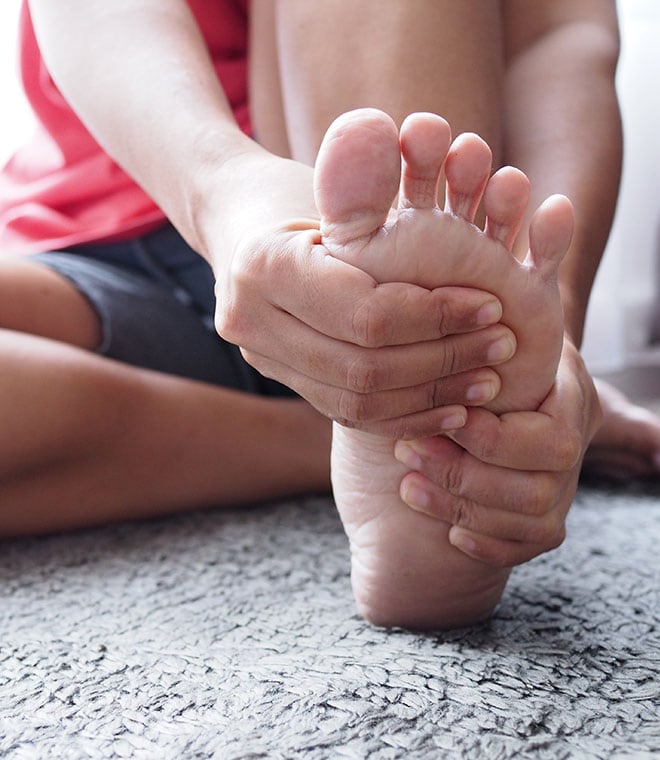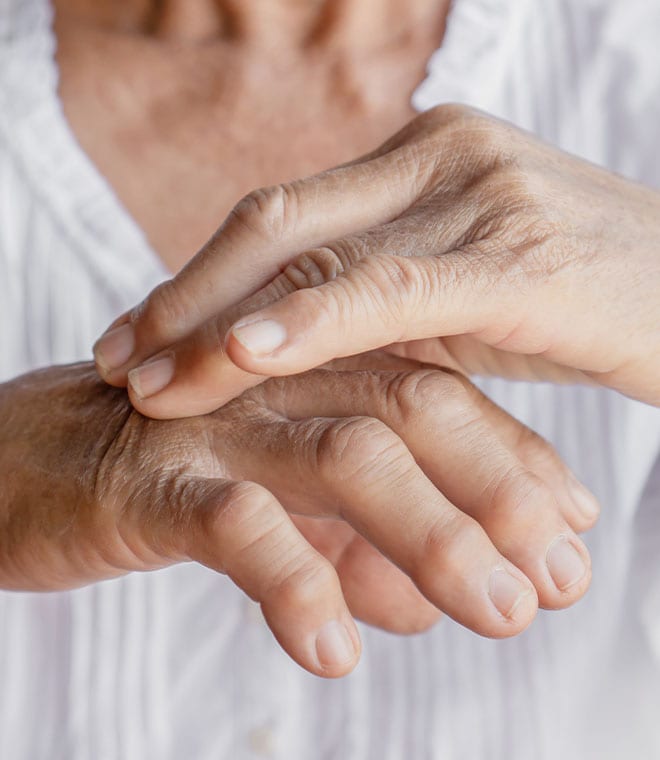Health
What are some common diabetic skin conditions?
By Dr. Anna H. Chacon, MD, Fellow of the American Academy of Dermatology Oct 19, 2023 • 8 min
Diabetes occurs when blood glucose levels become (and remain) too high. Chronic elevated blood glucose levels can impact many parts of the body, including your skin. Diabetic skin symptoms may indicate that your treatment plan needs to be adjusted to better control your blood sugar levels.
Necrobiosis lipoidica diabeticorum
A rare skin condition, necrobiosis lipoidica diabeticorum, or NLD, may develop as a complication of type 1 or type 2 diabetes. Women are more commonly affected than men. This condition often begins as small, raised bumps that look similar to pimples.
Over time, the bumps turn into patches of swollen skin that is yellow, reddish or brown in color. Skin surrounding the patches may look shiny, and you may be able to see blood vessels within the patches. For many people, the diabetic skin lesions associated with NLD come and go.
Diabetic dermopathy
Changes in blood vessels due to diabetes can also cause diabetic dermopathy, characterized by light brown, scaly patches of skin that are often round or oval-shaped. Their coloration makes them easy to confuse with age spots. Because diabetic dermopathy most often appears on the legs, some people refer to this condition as “shin spots.”
Generally, diabetic dermopathy doesn’t cause itching or pain, and it’s unlikely to lead to complications. Beyond better controlling blood sugar levels, treatment for diabetic dermopathy usually isn’t needed.
Acanthosis nigricans
Also known as AN, acanthosis nigricans develops when levels of insulin in the blood are abnormally high. It appears as dark, velvety patches or bands around the base of the neck, in the groin or in the armpit, but it can also occur in other areas. AN is most common in people who are overweight or obese, and it may be a symptom of prediabetes or early type 2 diabetes.
Digital sclerosis
About one-third of people with type 1 diabetes develop digital sclerosis, a condition marked by a buildup of thick, waxy, hardened skin. It often occurs on the backs of the hands, where it can cause the joints to become stiff and make it difficult for a person to move their fingers. From there it may spread to the face, shoulders and chest.
In rare cases, digital sclerosis forms on the ankles, elbows or knees and can lead to mobility issues.
Bullosis diabeticorum
Although rare, blisters called bullosis diabeticorum may occur in people with diabetes. The fluid-filled blisters may occur on the fingers, hands, toes, feet, legs or forearms. Although they can grow quite large, the blisters aren’t typically painful, and they usually heal on their own in a few weeks. People who suffer from diabetic neuropathy (nerve damage) are more likely to develop diabetic blisters.
Infections
Diabetes can suppress the immune system, making a person more prone to all types of infections, including those that affect the skin. Fungus and bacteria can both cause diabetic skin infections anywhere on the body. Symptoms vary from infection to infection and may include:
- Dry, scaly skin
- Hot skin
- Itchy rash
- Painful skin
- Swelling
- Tiny blisters
- White cottage cheese-like discharge from skin
Diabetic ulcers
Elevated blood sugar levels can reduce circulation and cause nerve damage, slowing the healing process. If a person with diabetes suffers a skin injury, the wound may remain open for a prolonged period of time. Healthcare providers refer to these open wounds as diabetic ulcers.
Most often, diabetic ulcers develop on the feet, which is why medical professionals recommend that people with diabetes check their feet for diabetic ulcers and other diabetic foot problems on a daily basis.
Eruptive xanthomatosis
Uncontrolled diabetes can lead to eruptive xanthomatosis, a condition that resembles tiny pimples in its early stages. As it progresses, the bumps take on a yellowish color and often begin to itch. The surrounding skin may grow red.
Eruptive xanthomatosis is most likely to occur on the feet, arms, legs, buttocks and backs of the hands. It is most common in men with type 1 diabetes. People with high cholesterol and high triglycerides are also at a higher risk. Typically, eruptive xanthomatosis clears up once blood sugar levels are under control.
Disseminated granuloma annulare
Granuloma annulare is a skin rash made up of tiny bumps that are pink, red, bluish-purple or skin-colored. It most often occurs on parts of the body that are distant from the torso, like the arms and legs.
Unlike many other diabetic skin conditions, granuloma annulare can also occur in people who don’t have diabetes, although studies have found that individuals with diabetes may be at an increased risk for the rash. As a result, healthcare providers may test people who have recurring granuloma annulare for diabetes.
Chronic dryness
When blood sugar levels become elevated, the body produces more urine to try and remove the excess glucose. To do so, it needs more fluid than usual, and it often draws fluid out of skin cells. This can lead to chronic dry skin, which may be accompanied by roughness, flakiness and itching. Poor circulation can also contribute to dry skin.
Although not always a symptom of early stage diabetes, itchy skin is a common symptom that often arises in diabetes due to dryness. People often experience itching in a single area, such as the lower parts of the legs.
Xanthelasma
Yellowish, scaly patches located on or around the eyelids are known as xanthelasma. This skin condition occurs when levels of fats in the blood are abnormally high, and it can occur in people with poorly controlled diabetes.
Skin tags
Often found on the eyelids, along the neck, in the armpit and around the groin, skin tags are harmless skin growths that dangle from a stalk. Although they can occur in people who don’t have diabetes, high levels of insulin can contribute to their formation. Having a large number of skin tags can be a warning sign of prediabetes or type 2 diabetes.
Treating type 1 and type 2 diabetes skin problems
If you develop a diabetic skin rash or lesion, let your healthcare provider know as soon as possible. They can discuss treatment options with you and address the problem before it causes further complications. In addition, your healthcare provider can review your current diet, lifestyle and treatment plan with you and make changes as needed to better control your blood sugar and reduce the risk of future skin problems.
Published October 2023.
Sources:
- https://www.aad.org/public/diseases/a-z/diabetes-warning-signs
- https://diabetes.org/diabetes/skin-complications?form=FUNCRXARWZF
- https://www.cdc.gov/diabetes/library/features/diabetes-and-your-skin.html
- https://www.cdc.gov/diabetes/basics/diabetes.html
- https://www.aad.org/dw/dw-insights-and-inquiries/archive/2023/necrobiosis-lipoidica
- https://www.mayoclinic.org/diseases-conditions/type-2-diabetes/symptoms-causes/syc-20351193
- https://www.aad.org/public/diseases/a-z/skin-tags



